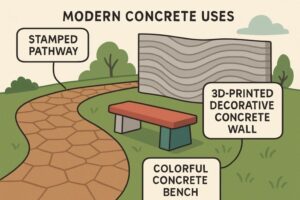Table of Contents
- Introduction
- 3D Printing
- Decorative Finishes
- Textured Surfaces
- Concrete Furniture
- Sustainable Practices
- Custom Colors and Pigments
- Innovative Formwork
- Benefits of Creative Concrete Designs
Introduction
Concrete continues to shape how we build, combining enduring strength with newfound creativity. Thanks to advancing techniques and materials, concrete is now at the forefront of innovative and visually remarkable construction. Whether you’re designing residential spaces, commercial facilities, or outdoor environments, the flexible nature of concrete allows for extraordinary possibilities that marry function with striking aesthetics.
From intricate decorative finishes to the eco-friendly use of recycled materials, concrete offers versatility and durability that few materials can match. More than ever, homeowners and professionals utilize concrete’s various applications to turn ordinary surfaces into extraordinary features indoors and out.
3D Printing
3D printing has brought unprecedented innovation to concrete construction, allowing for customized, complex forms and rapid prototyping. Concrete can now be extruded through a printer, layer by layer, to create curves and hollows, previously impossible or highly labor-intensive using traditional molds. For example, in Texas, the world’s first 3D-printed hotel is in development, illustrating how technology is pushing the boundaries of architectural design. This process accelerates the build time and reduces waste and material usage.
Beyond unique forms, 3D-printed concrete plays a significant role in sustainability by optimizing material quantities and minimizing on-site waste. This innovative application opens new avenues for affordable housing and complex infrastructure projects.
Concrete decks have also emerged as a popular application for traditional and modern techniques. These structures offer long-term durability and can be finished in countless decorative styles. For more information about customizing concrete decks, explore the latest designs and construction processes.
Decorative Finishes
Modern decorative techniques such as stamping, staining, and polishing can completely reinvent the concrete look. Stamped concrete mimics the appearance of natural stone, wood, or brick, providing the aesthetic appeal of high-end materials at a fraction of the cost. Stained concrete introduces rich color variations and intricate patterns that can transform a plain slab into the focal point of a room or outdoor space. Polished finishes highlight sleekness while improving durability, making them ideal for high-traffic areas in homes or businesses.
Textured Surfaces
Texture isn’t just about looks—it adds tactile dimension and function to concrete installations. Exposed aggregate is one technique where the top cement layer is removed to expose the stone or gravel beneath. The result is a slip-resistant and visually engaging surface perfect for walkways, driveways, and patios. Other finishing methods, like bush hammering or sandblasting, offer additional texture options that bring warmth and interest to otherwise hard surfaces.

Concrete Furniture
Concrete is no longer limited to floors and walls; it is now a centerpiece in contemporary furniture design. From sleek dining tables to robust benches and eye-catching planters, concrete furniture offers resilience and style in equal measure. Combined with wood, glass, or metal materials, the resulting contrasts create striking, modern aesthetics that seamlessly fit into indoor and outdoor environments.
Concrete furniture is especially valued for its ability to withstand weather elements, making it an attractive choice for patios and gardens. Its weight ensures stability, while custom molds and pigments allow for virtually any design style or color scheme.
Sustainable Practices
New concrete manufacturing and application approaches focus on reducing the construction’s environmental impact. Integrating recycled materials such as fly ash, slag, and even crushed glass into concrete mixes conserves resources and minimizes landfill waste. Permeable concrete, an innovation designed to allow water passage, helps manage stormwater runoff and enhances groundwater recharge, an important development in combating urban flooding and supporting green building initiatives.
For a deeper dive into the latest sustainable innovations in cement and concrete, check out this ArchDaily feature.
Custom Colors and Pigments
Concrete no longer means dull gray. Integral pigments, acid stains, and surface dyes can create a vivid range of hues that complement any architectural theme. Unlike surface paint, these coloring techniques bond with the concrete, promising hues that resist fading, chipping, and weathering for years. Whether you prefer earth tones for a natural vibe or bold statement colors, customization is virtually limitless, increasing the aesthetic value of any project.
Innovative Formwork
Thanks to new materials and techniques, formwork—the process of shaping poured concrete—has become remarkably efficient and flexible. Prefabricated and reusable panels decrease labor costs and environmental impact. Engineered wood, steel, and 3D-printed forms accommodate complex geometries, making ambitious designs possible. These advancements enhance construction speed and precision, producing high-quality, sustainable buildings.
Learn how innovative formwork is reshaping construction and design in this detailed report from Construction Dive.
Benefits of Creative Concrete Designs
Choosing creative concrete solutions yields a host of advantages. Durability and structural integrity remain unmatched, resulting in long-lasting, low-maintenance installations. Concrete’s moldability allows for an unlimited range of textures, shapes, and colors—perfect for contemporary and traditional aesthetics. Concrete’s thermal mass in buildings improves energy efficiency, reducing utility costs.
Moreover, concrete’s adaptability means it can be tailored for functional requirements, such as slip resistance or water permeability, while simultaneously achieving artistic goals. Embracing these inventive techniques and sustainable practices enhances the value, beauty, and resilience of any construction project, large or small.





